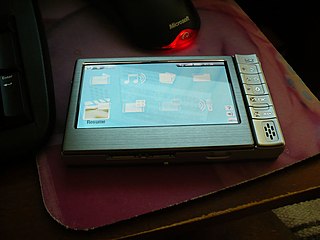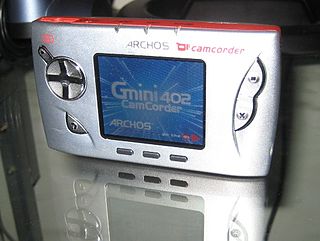
Windows Media Player (WMP) is a media player and media library application developed by Microsoft that is used for playing audio, video and viewing images on personal computers running the Microsoft Windows operating system, as well as on Pocket PC and Windows Mobile-based devices. Editions of Windows Media Player were also released for classic Mac OS, Mac OS X and Solaris but development of these has since been discontinued.
IRIVER is a South Korean consumer electronics brand operated by Dreamus. It markets music and other accessories in its domestic market. Internationally it was best known for its digital audio players and other portable media devices during the 2000s, when it was a competitor of the iPod from Apple. It was created in 1999 by seven former Samsung executives, releasing portable CD players.

ZEN is a series of discontinued portable media players designed and manufactured by Creative Technology Limited. The players evolved from the NOMAD brand through the NOMAD Jukebox series of music players, with the first separate "ZEN" branded models released in 2004. The last Creative Zen player, X-Fi3, was released at the end of 2011.

A portable media player (PMP) or digital audio player (DAP) is a portable consumer electronics device capable of storing and playing digital media such as audio, images, and video files. The data is typically stored on a compact disc (CD), Digital Video Disc (DVD), Blu-ray Disc (BD), flash memory, microdrive, or hard drive. Most portable media players are equipped with a 3.5 mm headphone jack, which users can plug headphones into, or connect to a boombox or shelf stereo system. In contrast, analogue portable audio players play music from non-digital media that use analogue signal storage, such as cassette tapes or vinyl records.
Archos is a French multinational electronics company that was established in 1988 by Henri Crohas. Archos manufactures tablets, smartphones, portable media players and portable data storage devices. The name is an anagram of Crohas' last name. Also, in Greek (-αρχος), it's a suffix used in nouns indicating a person with power. The company's slogan has been updated from "Think Smaller" to "On The Go", and the current "Entertainment your way".
Janus is the codename for a portable version of Windows Media DRM for portable devices, whose marketing name is Windows Media DRM for Portable Devices introduced by Microsoft in 2004 for use on portable media devices which store and access content offline. Napster To Go was the first online music store to require the Janus technology. Supporting Janus often implies that the device also make use of the Media Transfer Protocol (MTP).

iAUDIO is the brand name for a range of portable media players produced by Korean consumer electronics and software corporation Cowon Systems, Inc.

Yepp was Samsung Electronics' digital audio player brand until Samsung decided to retire most of their family brands in February 2011. From then on, their MP3 players were simply branded "Samsung" worldwide until they discontinued all of them late 2013. The brand included a wide range of hard-drive based as well as flash-memory based players. The name is claimed to be an acronym for "young, energetic, passionate person".
The Gigabeat was a line of digital media players by Toshiba.
The following comparison of portable media players compares general and technical information for notable digital playback devices.

My Life Online (mylo) was a device created and marketed by Sony for portable instant messaging and other Internet-based communications, browsing Internet web sites and playback and sharing of media files. The pocket-sized, tablet-shaped handheld device, which debuted in 2006, had a screen which slid up to reveal a QWERTY keyboard. The brand name 'mylo' stands for My Life Online. Using Wi-Fi instead of cellular networks, the mylo was targeted to the 18–24 age group.

The SanDisk Sansa is a line of 2- to 32-gigabyte flash memory-based portable media players produced by SanDisk since 2005.

Netgear's Digital Entertainer line of products are digital media players that can pull multimedia content from home computers to the typical audio/video entertainment center. There are three products in the line, the EVA700, the HD EVA8000 and the current EVA9150 Digital Entertainer Elite. All support high definition video, the EVA700 via component output up to 1080i and the EVA8000/EVA9000 up to 1080p with both component and HDMI connectors. All models support audio, video, image and streaming audio and video formats and can be networked via wired and wireless Ethernet. The EVA700 is Intel Viiv certified.

Archos Generation 4 were a series of Archos portable media players released from 2006 through 2007. The Generation 4 series is an upgrade to the previous AV and Gmini series, primarily the AV500s. There are 8 models in all. All players are Microsoft PlaysForSure compatible.

The Gmini is a series of portable audio and video players released by Archos in 2004 and 2005.
The Archos Jukebox is a series of Archos portable audio players from 2000 through 2002.

The Sansa Fuze is a portable media player developed by SanDisk and released on March 8, 2008. The Fuze is available in three different Flash memory capacities: 2 GB, 4 GB, and 8 GB and comes in six different colors: black, blue, pink, red, silver, and white. Storage is expandable via a microSDHC slot with capacity up to 32 GB, and unofficially to 64 GB or more via FAT32 formatted SDXC cards. All models have a 1.9 inch TFT LCD display with a resolution of 220 by 176 pixels and a built-in monaural microphone and FM tuner; recordings of the latter two are saved as PCM WAV files.
The French consumer electronics company Archos manufactured a number of products which have since been discontinued.

The ARCHOS 101 Internet Tablet is part of the Archos Generation 8 tablet range, distributed between 2010–11. After a hardware upgrade, it was also part of Generation 9 range sold between 2011–12. It is a 10.1 inch (256.5 mm) Internet tablet with dual-boot capability running Android out of the box.

The Sansa Fuze+ is a portable media player manufactured by SanDisk as part of their Sansa line of MP3 players. The Fuze+ was released on September 1st 2010, and is the direct successor to the Sansa Fuze. The Sansa Fuze+ is available in five colors: Black, Blue, Purple, Red, and White. Internal storage capacities of the player vary by color.












